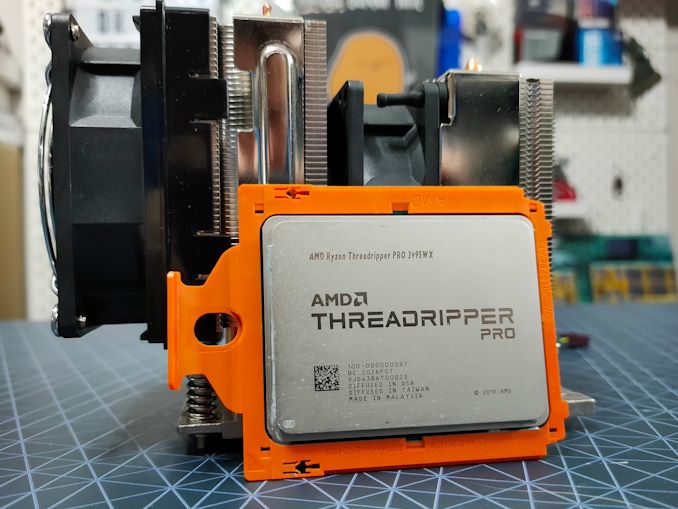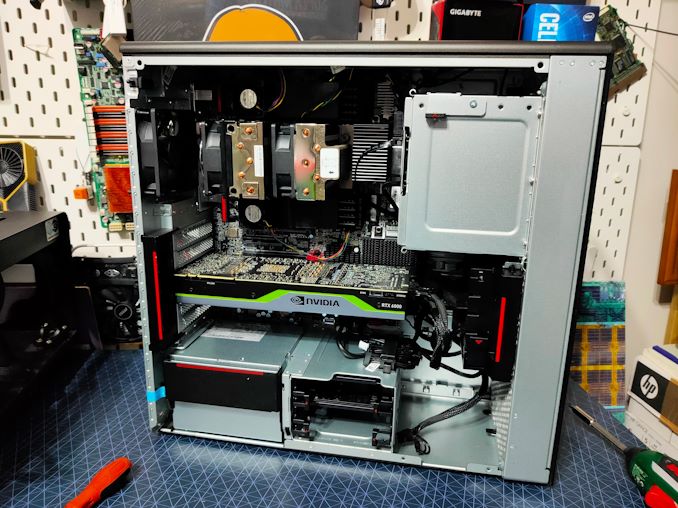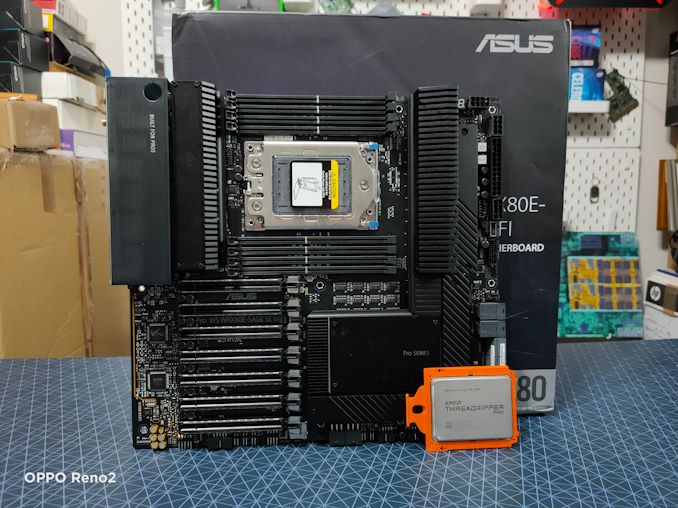64 Cores of Rendering Madness: The AMD Threadripper Pro 3995WX Review
by Dr. Ian Cutress on February 9, 2021 9:00 AM EST- Posted in
- CPUs
- AMD
- Lenovo
- ThinkStation
- Threadripper Pro
- WRX80
- 3995WX
Conclusions: Faster Than Expected
When I started testing for this review, looking purely at the specification sheet, I was expecting AMD’s Threadripper Pro 3995WX to come in just behind the 3990X in most of our testing. The same amount of cores, the same TDP, but slightly lower on frequencies in exchange for double the memory channels and 8x the memory support (also Pro features). More often than not our processor comparisons are usually testing systems with identical memory systems, or we don’t consider that memory difference that major in most of our testing. After going through the end data for this review, it would appear that it makes more of a difference than we initially had thought.
In the tests that matter, most noticeably the 3D rendering tests, we’re seeing a 3% speed-up on the Threadripper Pro compared to the regular Threadripper at the same memory frequency and sub-timings. The core frequencies were preferential on the 3990X, but the memory bandwidth of the 3995WX is obviously helping to a small degree, enough to pull ahead in our testing, along with the benefit of having access to 8x of the memory capacity as well as Pro features for proper enterprise-level administration.
The downside of this comparison is the cost: the SEP difference is +$1500, or another 50%, for the Threadripper Pro 3995WX over the regular Threadripper 3990X. With this price increase, you’re not really paying +50% for the performance difference (ECC memory also costs a good amount), but the feature set. Threadripper Pro is aimed at the visual effects and rendering market, where holding 3D models in main memory is a key aspect of workflow speed as well as full-scene production. Alongside the memory capacity difference, having double the PCIe 4.0 lanes means more access to offload hardware or additional fast storage, also important tools in the visual effects space. Threadripper Pro falls very much into the bucket of 'if you need it, this is the option to go for'.
For our testing, we used the Lenovo Thinkstation P620, the first Threadripper Pro system available in the market, and we’ll have a full review on it shortly. The Thinkstation Pro systems are always well designed workstations with longevity and professional workloads in mind, enabling 280 W cooling with a fun heatsink but also additional custom DRAM fans, a unique motherboard with an easily removable power supply, and support and space for a number of add-in cards. Lenovo’s units, if you buy them individually from the website, are eye-wateringly expensive (+$12200 for the 64-core CPU, a +120% markup), and it is recommended that any design studio that wants to test or order these units should work through a local distributor.
AMD is set to push Threadripper Pro into the consumer and commercial markets beyond Lenovo later this quarter. We have already been in touch with local regional system integrators who are already examining their options based on the three Threadripper Pro motherboards set to be available in the market from ASUS, GIGABYTE, and Supermicro. We are expecting a range of options to be available, and most design studios are likely to order pre-built systems with a variety of air and liquid cooling.
What might confuse a few users is that AMD is launching Threadripper Pro into the major market now, right on the cusp of its next-generation EPYC launch in the next eight weeks. These new EPYC processors should afford a sizeable raw compute upgrade moving to Zen 3 cores, all while Threadripper Pro is on Zen 2. As we saw comparing TR Pro to EPYC in this review, both on Zen 2, in some circumstances it is the push up to 280 W where TR Pro gets the best performance, and a 280 W version of next-generation EPYC might seem more appealing to users looking at TR Pro today. What exactly AMD will launch for EPYC is unknown, whereas TR Pro on this generation is now a known performance factor that system integrators are building on for the workstation market. EPYC never really fit into the workstation market that easily, which is why TR Pro exists today.
We have heard some conflicting dates as to when exactly Threadripper Pro will come to the mass market beyond Lenovo, but they all fall within Q1. We have reached out to AMD in order to source the other processors for our testing.














118 Comments
View All Comments
brucethemoose - Tuesday, February 9, 2021 - link
There are large efforts in various communities, from Rust and C++ to Linux distros and game engines, to improve autovectorization.This means that more software should support AVXwhatever with minimal or no support from devs as time goes on.
Also, one can"t always just "go to the GPU." Video encoding is a great example where this won't work.
RSAUser - Wednesday, February 10, 2021 - link
NVENC seems to work pretty well.eastcoast_pete - Wednesday, February 10, 2021 - link
The newest generation of NVENC (since Turing) is indeed quite capable at encoding and transcoding to AVC and h265. That ASIC has come a long way, and is really fast. However, for customized encoding situations, the story shifts; that's where CPU-based encoding comes into its own. Also, if you want AV1 encoding, we're still OOL on GPUs; if that has changed, I'd love to know. Lastly, a lot of the work these workstations are used for is CGI and editing, and for those, a combination of lots of RAM, many-core CPUs like these here and 1-2 higher end GPUs is generally what people use who do this for a living.GeoffreyA - Friday, February 12, 2021 - link
NVENC, VCE, etc., work brilliantly when it comes to speed, but if one is aiming for best quality or size, it's best to go for software encoding. x264 does support a bit of OpenCL acceleration but there's hardly any gain, and it's not enabled by default. Also, even when AV1 ASICs are added, I've got a feeling it'll fall well below software encoding.phoenix_rizzen - Tuesday, February 9, 2021 - link
More like, unless you absolutely NEED AVX-512 support, there's absolutely no reason to use an Intel setup.Pick a Ryzen, Threadripper, or EPYC depending on your needs, they'll all be a better value/performer than anything Intel currently has on the market.
twtech - Tuesday, February 9, 2021 - link
It's workload-dependent, and what you're looking for. While regular TR supports ECC, it doesn't support registered ECC, which is 99% of ECC memory. The 8 memory channels also make a big difference in some workloads, such as compiling code. Also the TR Pro has a lot more PCIE lanes, as well as better support for business/corporate management.So I agree with your statement if you are a solo operator with a workload that is not only not very memory dependent, but not very memory-bandwidth dependent either.
eastcoast_pete - Wednesday, February 10, 2021 - link
For the use case covered here (customized CPU rendering), those many cores are hard to beat. In that scenario, the main competitors for the TR pros are the upcoming, Zen 3-based Epyc and non-pro TRs. Unfortunately, Intel is still way behind. What I wonder about also is whether some of these rendering suites are also available for ARM's Neoverse arch; some of those 128+ core CPUs might be quite competitive, if the software exists.wumpus - Wednesday, February 10, 2021 - link
I'm guessing that a lot of the times that feature will be ECC. How many tasks worth doing on a 5-figure workstation are worth having botched bytes thanks to a memory error?Granted, a lot of the times that ECC is needed are also going to be the >256GB cases, but ECC is pretty important (if only to known that there *wasn't* a memory error).
The Hardcard - Tuesday, February 9, 2021 - link
While the EPYC name is epic, it doesn’t scream “for heavyweight computational workloads” like Threadripper does. Both names are candidates for bonuses, but whoever thought up Threadriipper should get the bigger one.If the same person is responsible for both names, then the title AMD Marketing Fellow was earned.
Oxford Guy - Tuesday, February 9, 2021 - link
Threadripper is even more corny than EPYC. Neither inspire much confidence from a professional standpoint, sounding like gamer speak.